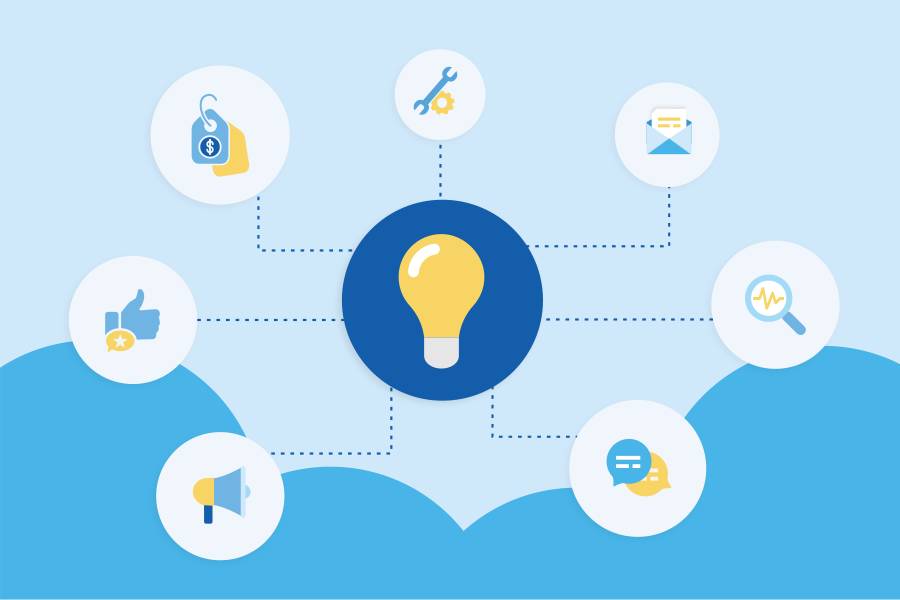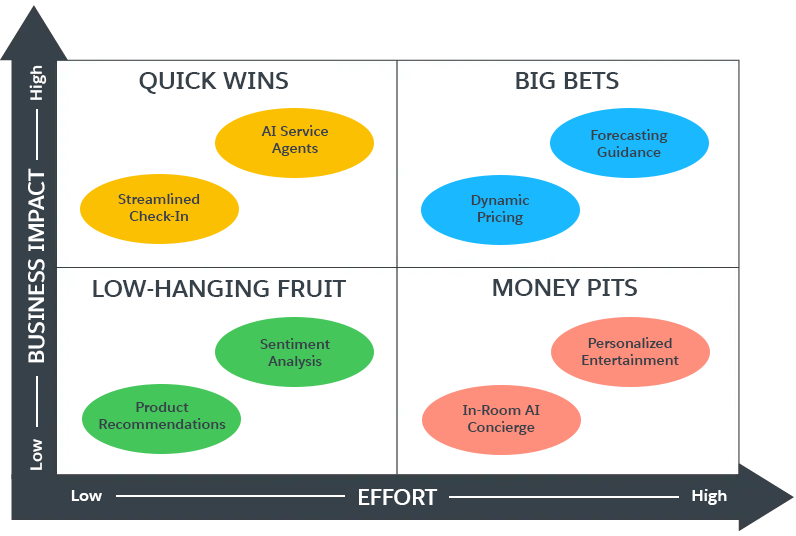Identify AI Use Cases
Learning Objectives
After completing this unit, you’ll be able to:
- Explain what makes a good AI use case.
- Build a prioritized AI backlog.
- Choose your first AI project.
Trailcast
If you'd like to listen to an audio recording of this module, please use the player below. When you’re finished listening to this recording, remember to come back to each unit, check out the resources, and complete the associated assessments.
Bring AI to Your Business
AI has the power to transform all areas of the enterprise, including sales, service, marketing, legal, human resources, finance, information technology, product development, operations, and more. But for your AI program to succeed, you need to choose the right use cases for your business. And the right use cases are the ones that align with your organization’s goals and deliver actual value. If you don’t select your AI projects carefully, they might not achieve the desired outcomes or even get implemented at all.
Let’s catch up with Coral Cloud and find out how they build their prioritized AI backlog of use cases.
Gather Ideas for Use Cases
First, Coral Cloud’s AI committee wants to start coming up with ideas for potential use cases, and there are a few ways to get the creative juices flowing.
-
Internal crowdsourcing: Encourage employees to experiment and submit suggestions. You can host hackathons and workshops, conduct surveys, set up an idea exchange site, or establish communities (such as Slack channels) to promote education and knowledge sharing.
-
Business process review: Conduct an in-depth analysis of all your business processes to learn where there are inefficiencies, pain points, and areas where automation and AI can have a significant impact.
-
User research: Involve the user research team in the ideation stage to make sure that potential AI use cases solve real problems for users.
-
Data analysis: Your data experts can evaluate patterns and work their data magic to find ideas for AI use cases.
-
Market trends and research: Use market research to find gaps and opportunities, anticipate changing buyer behavior, and study market risks. Conduct a competitive analysis to understand what competitors are doing with AI so you can assess the strengths and weaknesses of your own AI roadmap.

Coral Cloud’s AI leadership team uses a few of those methods to kick off the ideation process and gather a wide range of ideas.
Coral Cloud’s Use Cases
Thanks to the company’s comprehensive and collaborative approach, Coral Cloud came up with an impressive list of potential use cases for AI. Let’s take a look at a few of them.
Business Function |
AI Use Cases |
Business Value |
|---|---|---|
Sales |
Automated prospecting: Implement an AI agent that helps sellers by creating new pipeline, engaging and qualifying leads, and booking meetings on behalf of the seller. |
Boost revenue. |
Forecasting guidance: Use AI to predict how much the sales teams will sell at the end of a forecasting period. |
Boost revenue. |
|
Customer Experience |
Sentiment analysis: Implement AI to analyze guest reviews and feedback across various channels to quickly identify areas of improvement and take action when customers are dissatisfied. |
Improve guest satisfaction scores. |
AI service agents: Deploy AI agents on the resort’s website and mobile app to quickly handle common questions and issues. |
Reduce costs and improve guest satisfaction scores. |
|
Streamlined check-in: Use AI to precapture guest information to save time and personalize the check-in process to recommend relevant guest activities and add-ons. |
Increase cross-sell conversion rates and improve guest satisfaction scores. |
|
Marketing |
Product recommendations: Use AI to analyze guest preferences and past behavior to send personalized promotions and information about events and activities at the resort. |
Increase cross-sell conversion rates. |
Operations |
Dynamic pricing: Use AI to analyze market demand, competitor pricing, and historical data to adjust room rates in real time. |
Boost revenue and increase occupancy rates. |
Predictive maintenance: Implement AI to predict when resort equipment and facilities are likely to need maintenance. |
Reduce costs and improve guest satisfaction scores. |
That’s a sneak peek at a few of the AI possibilities that Coral Cloud dreamed up. For more inspiration, check out the Salesforce AI Use Case Library that showcases specific ideas for different business functions.
Assess the Use Cases
Now comes the hard part. With so many ideas, how does Coral Cloud figure out which use cases they should actually implement? Alex, the VP of business intelligence, walks the organization’s AI committee through the factors to consider.
Business Value
As you learned earlier, the ideal use cases align with your organization’s strategic objectives, and they also deliver tangible business value. You can calculate that value using internal-rate-of-return or net-present-value analysis, ROI, payback period evaluation, scenario modeling, opportunity cost assessment, or whatever estimation technique is appropriate for your organization. Don’t forget to take into account both short-term and long-term gains for each use case. And be sure to think about leveraging existing investments. For example, if your organization already has a software platform that offers built-in AI tools, you might achieve more ROI by focusing initially on implementing a few use cases with that platform.
It’s also critical to define the metrics and key performance indicators (KPIs) you’ll use to measure the project’s success. If you can’t prove that the project resulted in better business outcomes, you’ll have trouble building momentum for future AI initiatives.
Ease of Implementation
In addition to calculating the business value, organizations should evaluate how difficult an AI project is to implement. To assess the implementation effort, keep these things in mind.
-
Technical feasibility: Consider the project’s complexity, approximate timeline, scalability, and the technical requirements, which can include the necessary technology, infrastructure, system integrations, cybersecurity guardrails, and so on.
-
Operational readiness: Each use case demands a different level of AI maturity and expertise to implement. Also estimate the cost of the change management process for launching the project; weigh factors such as the project’s size and scope, amount of training required, level of resistance to change, and potential disruptions to business operations.
-
Data readiness: Evaluate how much effort it’ll take to prepare the required data so it’s available, high-quality, unified, and well-governed. Also, some use cases might call for upgrades to your data storage capabilities or data infrastructure. Don’t forget to note which use cases can potentially take advantage of the same data sets; prioritizing those use cases is a great way to get more return on your data investment.
-
Risks: If you’re new to AI, try starting with low-risk, high-impact use cases. But balance quick wins with higher-risk opportunities that can lead to AI transformation and a more robust ethical AI practice.
-
Executive buy-in: Use cases with strong leadership support will often have a smoother implementation path.
Alex and Coral Cloud’s AI leadership team carefully assess all of their AI use cases so they can decide which ones are worth pursuing. Keep in mind that some of the nitty-gritty investigation and due diligence will happen when the organization kicks off the planning stage of each project. While developing their AI strategy, the committee does just enough work to estimate the value of each use case and how much effort it could take.
Build a Prioritized AI Backlog
As Coral Cloud’s AI committee evaluated the use cases, they added each one to their project management tool. Now they have a backlog of all the potential AI use cases so they can keep track of the projects. The next step is prioritizing their backlog.
There are many ways to prioritize projects, but one simple method is an impact-effort matrix that compares business value to ease of implementation.
Let’s see where Coral Cloud’s use cases fall if we plot them on a simple graph.
-
Quick wins: Use cases in the upper left quadrant are high-value and low-effort. If you’re relatively new to AI, start here when selecting pilot projects. Coral Cloud puts streamlined check-in and AI service agents here.
-
Low-hanging fruit: Use cases in the lower left quadrant are low-value and low-effort. Tackle them when more important projects are complete or while waiting for obstacles to be resolved. Coral Cloud puts sentiment analysis and product recommendations here.
-
Big bets: Use cases in the upper right quadrant can lead to major transformation, but they require a lot of effort and therefore more risk. Coral Cloud puts dynamic pricing and forecasting guidance here.
-
Money pits: Use cases in the lower right quadrant are low-value and high-effort, so they aren’t worth pursuing. Coral Cloud puts in-room AI concierge and personalized entertainment here.

If the impact-effort matrix isn’t appropriate for your organization, check out the Resources section to learn more about different prioritization frameworks.
Choose Your First AI Project
After completing the prioritization exercise, Coral Cloud’s AI leadership team has identified some quick-win, high-value projects to potentially implement. Which one should they choose first?
Coral Cloud keeps these factors in mind when deciding on a pilot project.
-
Size and speed: They narrow down their list to three projects that can be implemented in less than 6 months with off-the-shelf AI solutions and very little data cleanup or integration.
-
Risk and success: They choose those projects that are low-risk with a high likelihood of success. Demonstrating measurable business results will gain more traction for the AI program.
-
Organizational fit: They evaluate which of the projects aligns with the organization’s current capabilities and resources.
-
Ease of adoption: They consider how easy the AI projects are for users to adopt and how much change management is required.
-
Scalability: They take into account which use cases can potentially be scaled up to other business units or geographic regions.
-
Learning opportunity: They think about which projects can provide the most valuable lessons in different aspects of AI deployment, such as data handling and integration.
At the end of a long deliberation, the AI committee finally picked the big winner: the streamlined check-in process from the Customer Experience team! With that decision made, Coral Cloud is well on the way to AI transformation.
Evolve Your AI Strategy
One of the benefits of conducting AI pilot projects is that the results of those experiments can help you test and refine your AI strategy. Alex and the rest of Coral Cloud’s AI committee make sure to revisit their strategy after every AI project launch, and on a quarterly basis to reevaluate and reprioritize based on new ideas, changing goals and requirements, and AI technology advancements. And of course, with each AI deployment, they remember to update their AI inventory for compliance purposes.
To see what steps Coral Cloud took to successfully plan their pilot project for the AI-powered check-in enhancements, check out the AI + Data: Project Planning module. Then continue on to the Connect Data 360 to Agentforce and Prompt Builder project, where you’ll get hands-on and follow along step-by-step as Coral Cloud’s admin implements the project in Salesforce.
Now it’s your turn! Take what you learned in this module and help your organization develop its own AI strategy so you can navigate this technological shift, build a roadmap that gradually advances your AI capabilities, and deliver tangible value with AI. With your shiny new AI strategy in hand, you’ll be one step closer to AI transformation.
Resources
- PDF: Applying AI: How to find and prioritize AI use cases
- External Site: The Ultimate Guide to Product Prioritization + 8 Frameworks
- Salesforce Webinar: Building Your AI Roadmap: 5 Strategic Steps to Success (sign-up required)
- Salesforce Architect: AI Roadmapping
- External Site: How to Choose Your First AI Project